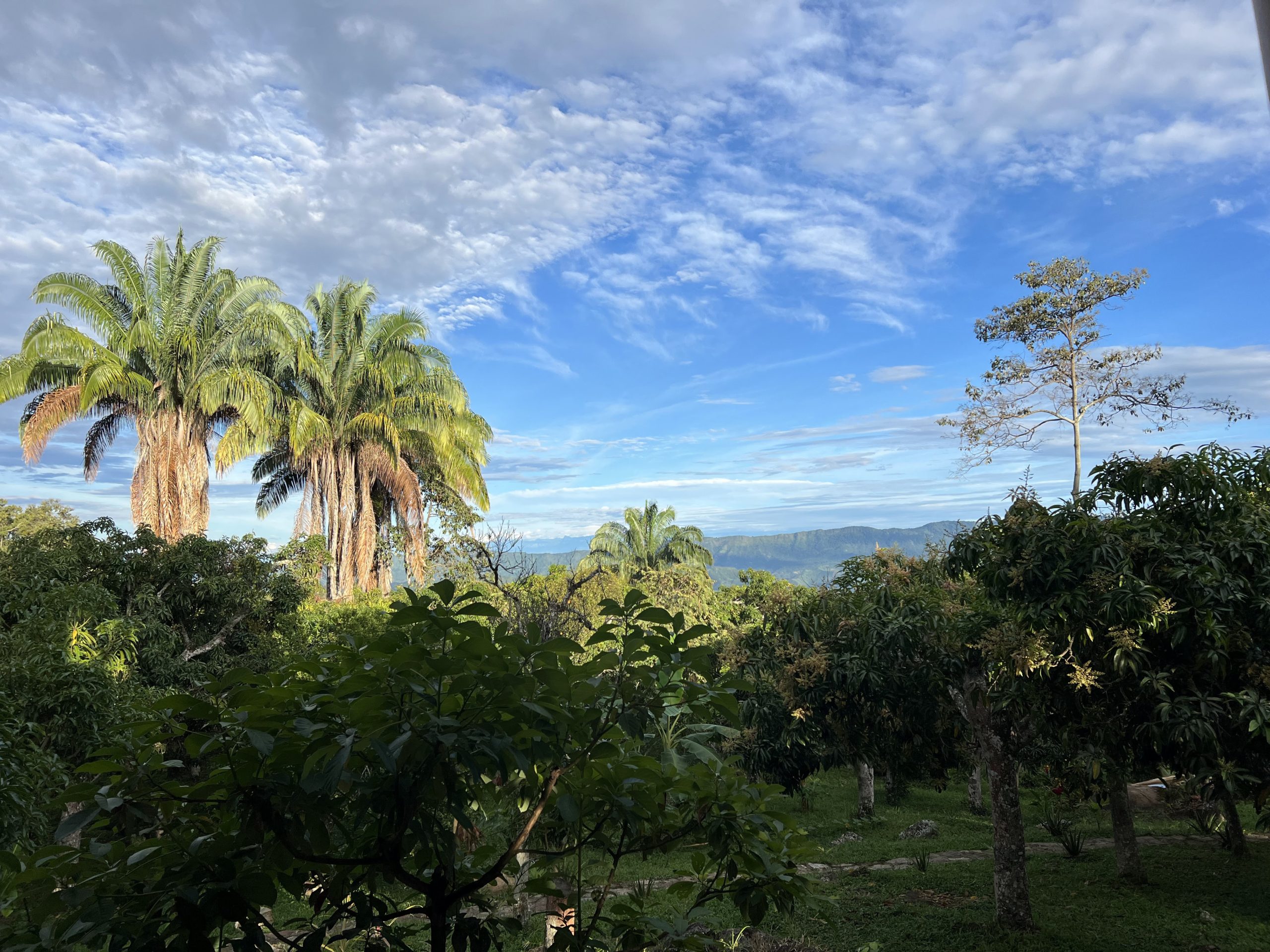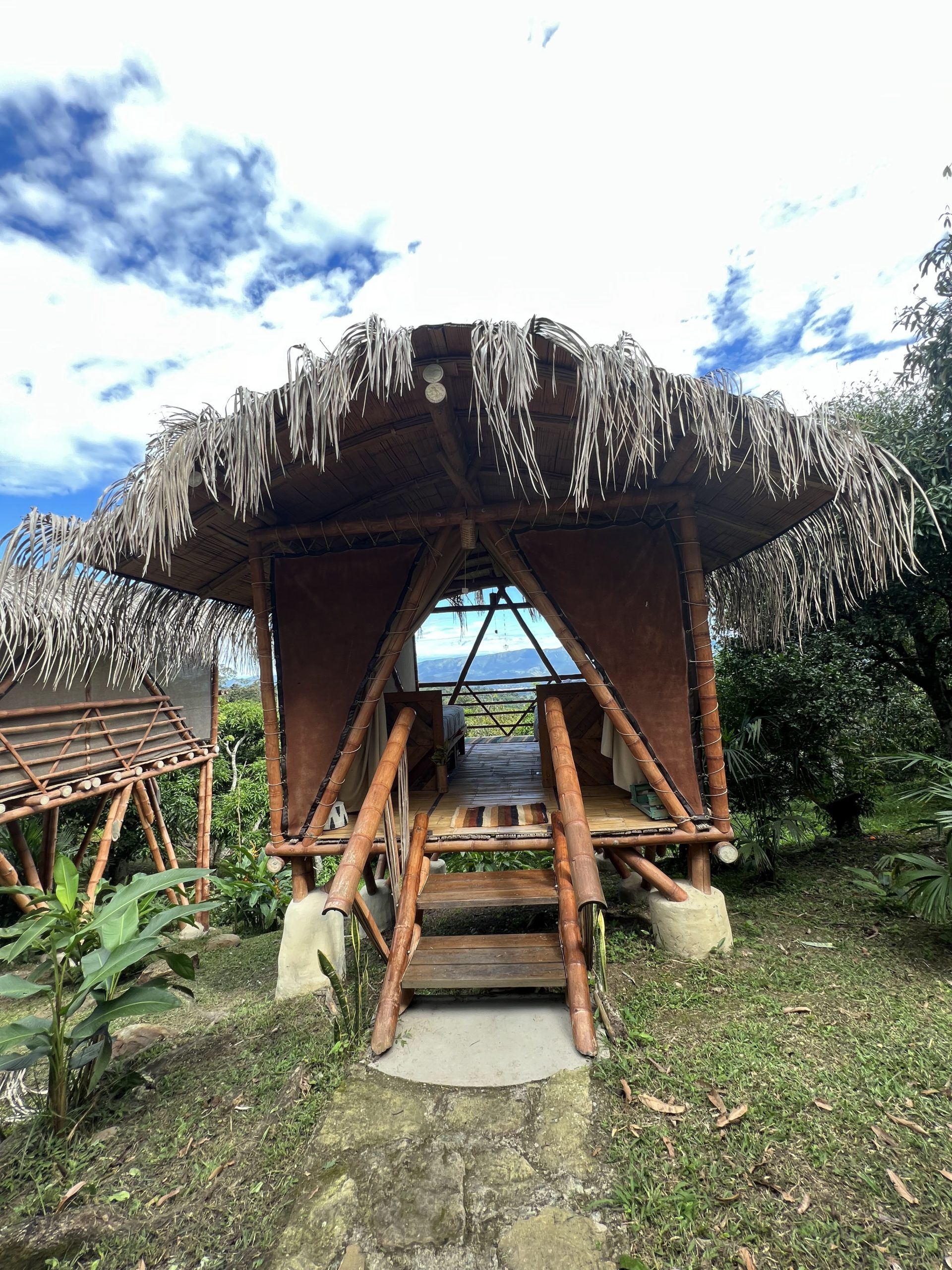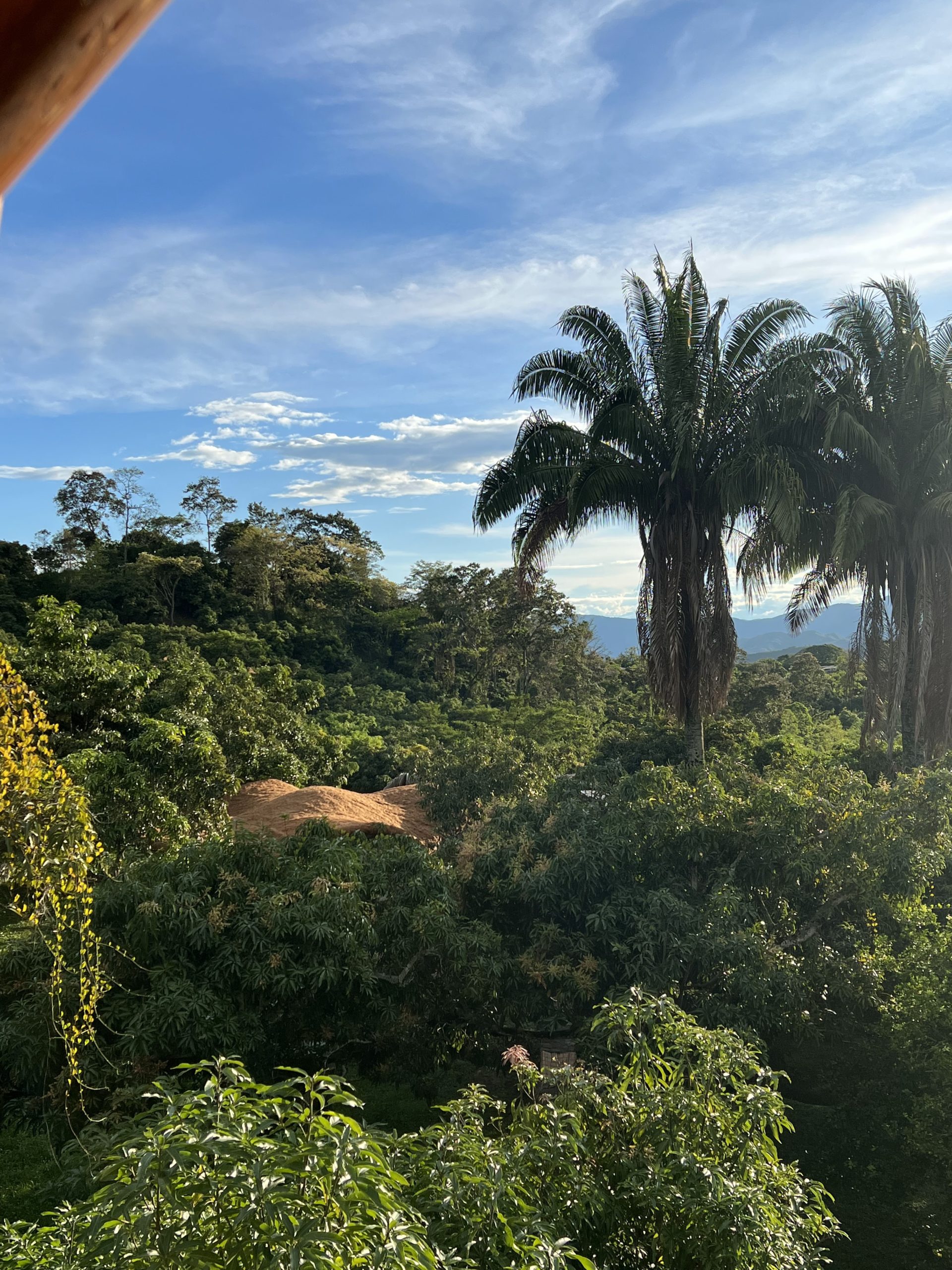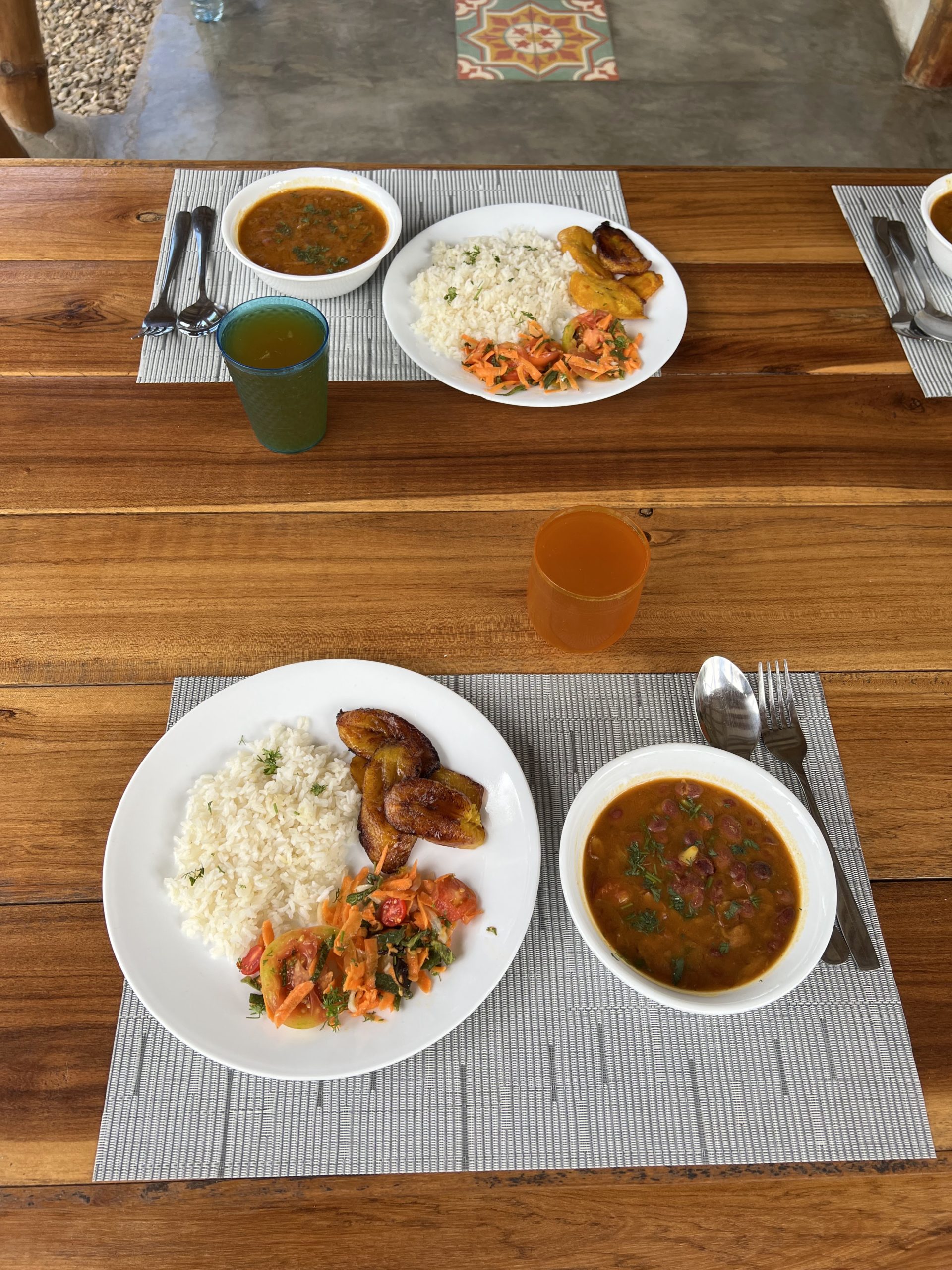For our last stop in South America, we found another Workaway on a farm where we could stay and eat in exchange for work. Located near the town of Anapoima about 2 hours from Bogota, the climate is a perfect 80 degrees and sunny everyday (except for a few rain storms that apparently have been happening more and more frequently these last few years). Unlike our last Workaway experience, this place was much more established and we had a set schedule of working hours everyday. But unfortunately exactly like our last Workaway experience, we were very rudely interrupted by Covid. Four days after we arrived, John started to feel a little sick and tested positive for Covid. We ended up leaving the Workaway to wait out his isolation period, but they thankfully let us come back once John started feeling better. Maybe someday we’ll actually be lucky enough to stay at a Workaway for as long as originally planned!
We volunteered at a place called Cultivarte, which is both an organic farm and a yoga retreat. It is run by a Colombian woman and an Israeli man, Natalia and Eyal. And to say we were impressed by their place is an understatement. They own a huge piece of land, most of which is full of fruit trees but also has several beautiful bamboo structures dispersed throughout. We all lived in the main building where all of the volunteers share a large room on the bottom floor. The showers were ice cold – seems to be a trend in Colombia – but the beds were nice and we had mosquito nets so it was a very comfortable place to stay.
Natalia and Eyal are very focused on conservation and low-impact living, so all of their projects used natural materials and produced as little waste as possible. For instance, every empty plastic jug would be stuffed full of any plastic bags/flexible plastic waste that was produced, and once full would be used as the interior structure of a wall. They have a place or use for every material, so the amount of actual trash we produced was impressively small!






The Work
We had a very set schedule for our working days on the farm. Every volunteer had a “morning task” that needed to be started at 7am. We then had an optional (but wonderful) yoga session put on by Eyal from 7:30-8:30am, after which we had breakfast. Then we worked from 9am-12pm (not a minute less), broke for lunch, and worked again from 2-4pm. They were the most structured days we’ve had the entire trip, and we honestly enjoyed it!
Our morning tasks included feeding the chickens/collecting eggs, sweeping floors, or feeding the pets. The work during the day varied quite a bit from day to day and even from morning to afternoon. Some highlights –
- Coconut Fiber Roof – we helped create a coconut fiber roof for their newest bamboo structure. We spent 2 days laying out a layer of coconut fiber, coating it with a natural latex, and then adding a layer of chicken wire and a second layer of fiber and repeating the process. John became the spray gun expert and got to clean gooey latex out of the spray gun after it inevitably clogged every 20 minutes or so. Once the fibers dried we passed it onto professionals who installed it on their most recent bamboo structure – it is amazing and waterproof and makes the structure look like a giant mushroom!
- Composting – they compost everything they can and place it in a series of bins that eventually turns to soil. Once a week someone has to dump each bin and stir it to aerate it and add in additional dry materials if it is too wet. This was my job during our first week, and it was both disgusting and amazing. Each bin was at a different phase of the composting process, so I got to stir a bin right in the middle of the decomposing process that was letting off a bunch of heat and was full of maggots and micro-organisms, but then also got to see one that was completely composted and had turned into very rich soil. We then dispersed that across their vegetable gardens, and the plants seem to be thriving!
- Building a wall – John and I built a small brick wall, including mixing the cement by hand. It was hard work but fun! We left before the cement was dry so we’re not sure what the final product looks like yet, but we’re excited to see the completed product after it has been painted.
- Homemade peanut butter – the best job we had all week was making homemade peanut butter. They have a bike that is hooked up to a grinder, and we put raw peanuts in it and ground them until it became a paste. We just added a tiny bit of salt and honey, and it was delicous!
- Woodworking – the structure with the coconut fiber roof has several beautiful teak tables that John sanded and stained.






The Food
One of the best parts of staying at Cultivarte was the food. As part of our working arrangement, a chef (Sara) came and cooked breakfast and lunch for us every weekday while we worked. It was always vegetarian meals, which was a very welcome change from the heavy meat diet we’ve had in South America. For breakfast we usually had some variation of oatmeal and fruit or arepas and eggs. There was always homemade hot chocolate (literally the chocolate was homemade from cacao fruit) or homemade tea made from herbs from the garden. The one downside was it was a coffee-free household, meaning they don’t provide coffee but they (thankfully) allow you to make it yourself if you want. There were several mornings where I didn’t have time to make coffee until our lunch break – which for people that know “Morning Christine” (for which I am affectionately known) you’ll be surprised to hear that I was very kind to everyone I encountered pre-coffee. Traveling Christine is new and improved!
Lunch varied between delicious soups, salads, rice dishes, and pastas, and was always served with freshly squeezed fruit juice from the farm. We typically ate the leftovers from lunch for dinner, which we had no problem with since they were so tasty. We also were allowed to eat as much fruit as we wanted from the farm, which led to a ridiculous amount of mango consumption. What a dream!
On weekends, us volunteers were put in charge of cooking dinner for the rest of the group. John and I cooked our Saturday night dinner, for which we made pesto/chickpea pasta and an eggplant dish with lots of fresh herbs. It was a bit of a challenge finding all of the ingredients at the local grocery store – and by local I mean a 30 minute collectivo ride away – but we made it work!



The Pets
The pets are a huge part of the family at Cultivarte and we loved them all. Almost every night at least one cat ended up sleeping on our bed – or I should really say they let us sleep on their bed. They each had very different but strong personalities and we already miss them, so to describe them each –
- Shula – a very sweet cat that was absolutely obsessed with John – whenever he sat or laid down, she would come lay on him and ignore everyone else.
- Rastastas – a very feisty cat that we were honestly kind of scared of until our second week. He’s a biter, and if you pet him wrong he will let you know. But by the end he tried to snuggle with us and ended up sleeping at our feet (whether we tried to kick him off the bed or not).
- Mancha – probably the sweetest dog I’ve ever met. She has a hip injury and limps a lot but also wants to play which was heartbreaking, but has the sweetest smile and was so happy to get pets.
- Shooshoo – the craziest giant puppy. Only 6 months old but probably 80 pounds, he does not know his size and thinks he’s a lap dog. We love him but if you left your shoes out at night they would be destroyed by morning. He was the one that kept things exciting for sure!




The Quarantine
As mentioned, Covid unfortunately finally found John a few days into our Workaway. All volunteers had to take Covid tests before we arrived, so our guess is he caught it from someone on our bus from Salento to Bogota. Amazingly, no one else at the Workaway tested positive so we’re grateful for that!
We managed to find a last minute Airbnb two towns over from our Workaway where we could wait out John’s isolation period. The town is called La Mesa, and it very clearly does not get many foreign tourists. Since John was stuck to the apartment I went out to grocery stores and walks by myself, and without fail I would be stopped by someone to say hi or try to talk to me and figure out why I was there. It was a good test of my Spanish skills without John to lean on (spoiler alert, I failed the test) but other than a few conversations I had to just say sorry and awkwardly walk away from I got by alright! The town itself is very cute and full of friendly people, and I got the impression it is a common place for Colombians from Bogota to vacation to get away from the city. The most awkward/memorable interaction was when I was walking to the grocery store one day and someone yelled “Gringa!” and everyone on the street turned and looked at me. I’m just here to entertain 🙂
After his isolation period, John being the responsible person he is didn’t want to go back to the Workaway and sleep in the same room as the rest of the volunteers until his full CDC quarantine period was over. So instead he paid a little extra and stayed in one of the glamping buildings that is reserved for yoga retreats – so don’t feel too bad for him with that set up! Thankfully it all worked out and John felt healthy again quickly, and hopefully this is the last Covid story I have to tell for this trip.


This was the perfect place to end the first leg of our trip. We both feel like we could spend many many more months exploring South America, and we definitely plan to come back and visit several countries that didn’t quite make our itinerary this time around! We’ve been spending August back in Seattle with our families before heading back out on our next adventure – it’s going to be a big switch and we’re very excited!

Christine